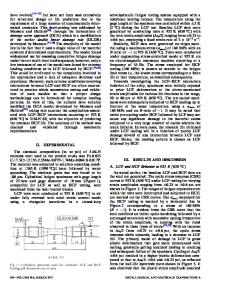Fatigue and creep-fatigue damage of
- PDF / 3,205,061 Bytes
- 15 Pages / 597 x 774 pts Page_size
- 56 Downloads / 353 Views
I.
INTRODUCTION
MOST structural components are subjected in service to complex loading conditions in regions of stress concentrations. This occurs, in particular, in high-temperature components which are submitted to superimposed mechanical and thermal stresses, leading to fatigue and creep multiaxial damage. For a long time, most of the studies dealing with fatigue damage at high temperature have been limited to uniaxial (mainly tensile) conditions. Brown and Miller tz,z~ were among the first investigators to emphasize the importance of the directional aspect of fatigue damage under multiaxial loading. At low temperature, without significant oxidation effect, fatigue cracks initiate on shear planes from persistent slip bands, whereas they propagate usually under tensile mode I, except for loadings approaching pure shear, i.e., for large values of the ratio A' = A y / A e between the shear strain range, AT, and the tensile strain range, Ae, and for large values of Ay. Crack propagation occurs under shear modes II and III in this case. t31 At high temperature (650 ~ the same behavior was observed by Sakane et al. f41 on 304 stainless steel for the propagation stage but not for the initiation stage which occurred under mode I. This directional aspect of fatigue damage plays a key role in the explanation of the results of sequential lowcycle fatigue (LCF) tests in which different sequences of J. WEISS, formerly with Ecole des Mines, is Visiting Scientist, Ice Research Laboratory, Thayer School of Engineering, Dartmouth College, Hanover. A. PINEAU, Professor, is with the Centre des Matdriaux, Ecole des Mines, 91003 EVRY, Cedex, France Manuscript submitted January 11, 1993. METALLURG[CAL TRANSACTIONS A
push-pull and torsional loading are applied. At room temperature, it is usually observed that the cumulative damage D = NffNF, + N2/NF2 is larger than one for the sequence tension -~ torsion and lower than one for the reverse.[5.6,7] The detrimental effect of sequential fatigue corresponding to the latter situation can easily be explained, at least qualitatively, by the fact that under these conditions, the initiation plane and the propagation plane have the same orientation. At elevated temperature, similar effects have not yet been reported to the knowledge of the authors. Fatigue lives in push-pull conditions are strongly reduced at elevated temperature, as a rule, tS1 and particularly for 316 stainless steels (e.g., Reference 9). The comparison of test results carried out under air or vacuum has shown that this reduction is largely due to environmental effects, especially oxidation, 191but very few studies have been devoted to the micromechanisms of oxidation damage. Without cyclic loading, a very thin layer of Cr203 oxide grows on the free surface of austenitic stainless steels. ~ml Several questions can be raised when the material is deformed. What is the role played by this CrzO3 film with respect to fatigue damage? Is there any change in the nature and in the growth kinetics of oxide film during cyclic loading?
Data Loading...











